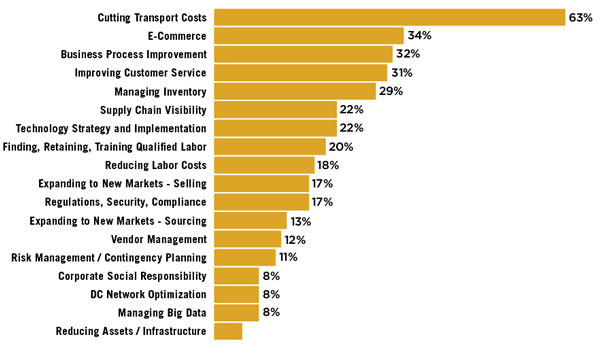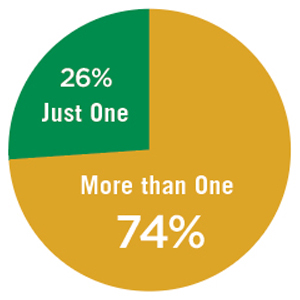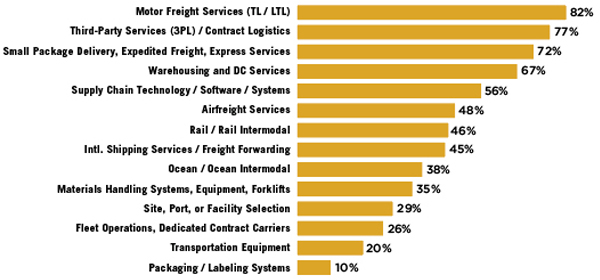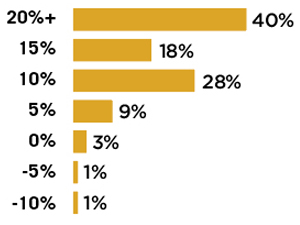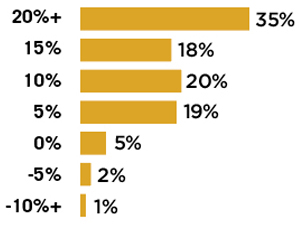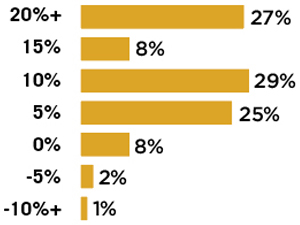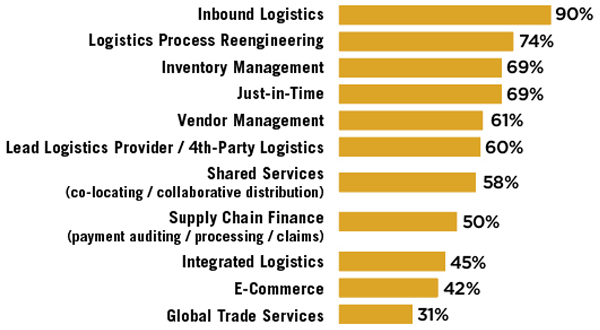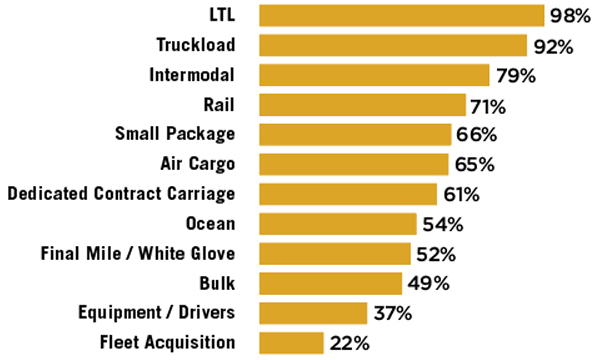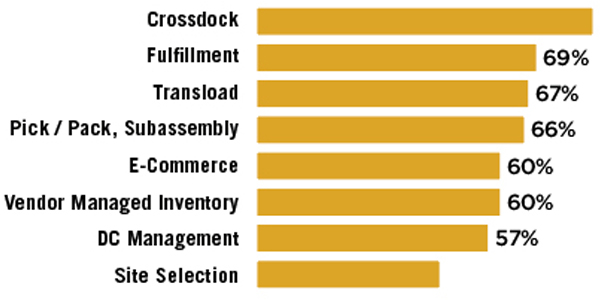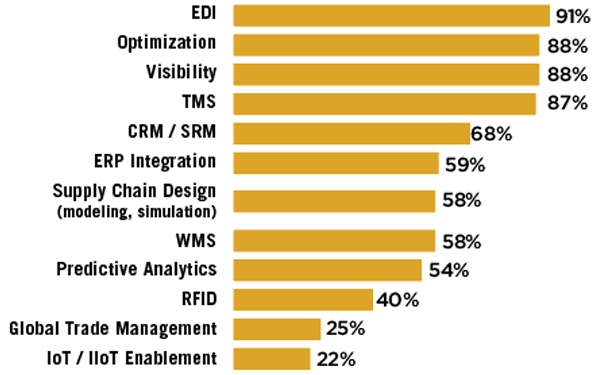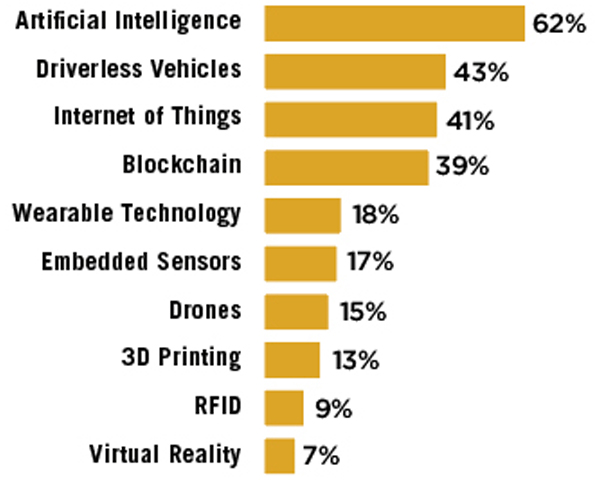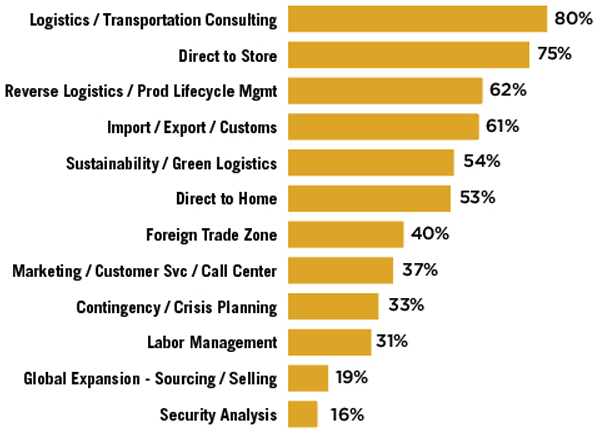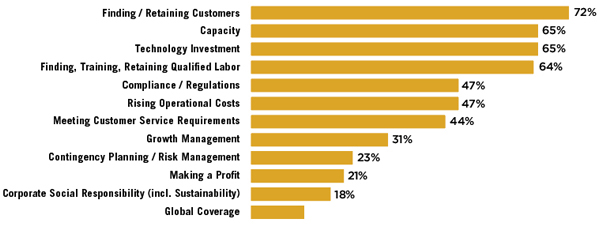3PL Perspectives 2019
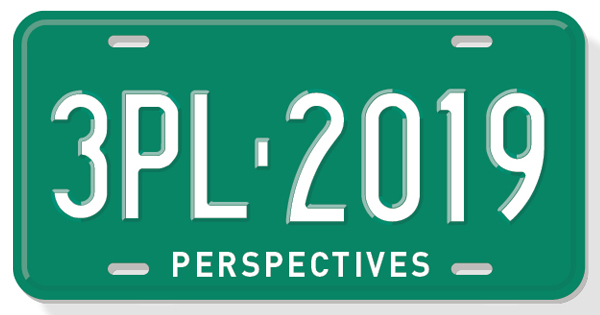
What does the road ahead look like for shippers and logistics service providers? In our 14th annual 3PL market research report, Inbound Logistics explores potential speed bumps and market movers.
These are prosperous times for third-party logistics (3PL) providers. According to the companies that responded to Inbound Logistics’ annual 3PL marketplace survey, a growing number of shippers these days outsource at least some of their supply chain activities to companies that specialize in those functions.
How to Find a 3PL-Third Party Logistics Provider
It’s no wonder those shippers seek expert help, given the complexity of today’s supply chain environment. International trade relationships keep blowing hot and cold, with the prospect of new tariffs on top of those already in place. U.S. companies scramble to get as much product into the country as they can before new tariffs kick in.
The economy is strong, but experts are unsure how long that boom will last. A tight labor market makes it hard to recruit and retain logistics talent. All these factors pose challenges for in-house supply chain organizations, and new opportunities for 3PLs.
Then there’s the frantic competition in the retail market, with pressure to fill orders faster and build flawless omnichannel operations.
That pressure squeezes companies even in the business-to-business (B2B) arena, with the Amazon effect conditioning customers of all kinds to demand exceptional service. Companies struggling to meet those demands while remaining profitable often look to 3PLs for help.
What Shippers Want
In our 14th annual 3PL Perspectives report, we look at how shippers collaborate with 3PLs to improve operations, deliver better service, cut costs, gain better control over inventory, and win competitive advantage. We also examine what’s driving success for the 3PLs responding to our survey.
Shippers are clear about the challenges they face in today’s world. Nearly two-thirds of them—63%—cite cutting transportation costs as an important focus of their logistics efforts. Managing e-commerce is a major concern for 34% of respondents, a new high for that category in the history of this survey.
Another challenge named by a record portion of respondents this year (29%) is managing inventory. Other challenges that weigh heavily on shippers’ minds include business process improvement (32%), and improving customer service (31%). (See Figure 1.)
FIGURE 1: TOP CHALLENGES SHIPPERS FACE
For help with those challenges, shippers often call on 3PLs, and many form partnerships with more than one service company. Among our respondents, 74% say they work with more than one logistics service provider. The 26% that work with just one 3PL represent an increase: In 2018, that number was 12%.
FIGURE 2: HOW MANY 3PLs DO YOU USE?
The increase does not mean shippers are pulling back to employ fewer service providers. Rather, small companies that never used a 3PL in the past have started to outsource for the first time, seeking a competitive edge in the highly competitive e-commerce market. (See Figure 2.)
Worthy of recognition
When we asked shippers to choose their top 3PLs and then explain why those companies merit recognition, respondents offered warm praise, describing the attributes they value in their service providers. A few examples:
- “Always find the best rates and always on time.”
- “Amazing work culture that makes them the best at serving customers.”
- “They all give me excellent service performance numbers. I do not have to babysit any of these companies, yet their service numbers are 90+%. Also they give me competitive pricing.”
- “On-time delivery and constant updates on shipments.”
- “Focus on company culture, people, and innovation.”
Among the services these shippers buy from their 3PLs, the most common are the ones you would expect: transportation and warehousing.
Truck transportation is the mode these shippers are most likely to purchase through a 3PL: 82% say they rely on third parties to handle truckload or less-than-truckload freight. Seventy-two percent turn to 3PLs for small package delivery, expedited freight, and express services.
After that, the numbers shrink. Approximately 48% of respondents buy airfreight services from 3PLs; 46% buy rail or rail intermodal services; and 38% use 3PLs to help them with ocean or ocean intermodal transportation.
Two-thirds of shippers who responded to the survey buy warehousing or distribution center (DC) services from 3PLs. And a healthy 56% look to 3PLs for technology solutions that help with supply chain management. (See Figure 3.)
FIGURE 3: SERVICES SHIPPERS BUY
Solid relationships with shippers have helped to create a banner year for the 3PLs in our survey. Taken together, their reported gross annual revenues total $142 billion. The actual figure is higher, since several of the privately held companies that responded to the survey did not provide financial information. One prominent 3PL on our Top 100 list reports more than $16 billion in gross revenue, a jump of 12% over 2018.
Figure 4: 3PL SALES GROWTH
That 3PL was far from the only one in our survey to enjoy healthy growth. Forty percent say sales have increased by 20% or more. For another 18% the growth rate is 15%, and 28% have grown by 10%. Only 2% of the 3PLs have seen sales fall since 2018. (See Figure 4.)
Figure 5: 3PL PROFIT GROWTH
Not only are 3PLs selling more, but they’re keeping more of the money they bring in. Thirty-five percent of respondents say profits have grown by 20% or more since 2018; 18% have seen 15% growth in profits; and 20% have seen 10% growth. (See Figure 5.)
Figure 6: GROWTH IN CUSTOMER BASE
The cumulative increase in 3PL revenues comes largely from new customers knocking at the door, rather than from current customers buying more services. Eighty-nine percent of the 3PLs who responded to our survey report that their customer bases have grown. Twenty-seven percent of them saw their customer base surge by 20% or more. (See Figure 6.)
So why all this expansion?
“Last year, shippers shifted to transportation providers who could provide needed capacity for both regular shipments and seasonal surges,” says one 3PL. “Market conditions (tight truck capacity, intermodal congestion) also helped. We are using more technology to improve fleet utilization, provide supply chain transparency, and make it easier for customers and suppliers (e.g., truck carriers) to do business with us.”
Another 3PL credits the environment in which its customers operate. “New client acquisitions are increasing over previous years due to the tight real estate market as well as the increased demand for e-commerce capabilities,” that respondent says. “Current customers are enjoying positive year-over-year growth in general, and especially in the e-commerce vertical. This generates more dollars per order processed within a 3PL.”
Some other observations:
- “Our growth can be attributed to both additional sales and improved contracts with existing customers. We have been implementing a strategic growth plan since 2013. We have recruited some of the supply chain sector’s top talent and had a major focus on enhancing the value we bring to customers by investing in people (both recruited talent and educational/training growth of our associates), quality, and advanced technology.”
- “Demand certainly still outweighs supply for 3PL distribution services. Additionally, we attribute a 250% increase in our sales pipeline to our marketing efforts and a 20% increase in new sales revenue over the previous 12 months. We’ve also made strategic decisions to exit unprofitable client agreements.”
Services in Demand
3PLs attract customers and drive growth with a wide range of services and capabilities. The service that our respondents are most likely to offer is inbound logistics management; 90% include that in their portfolios.
The second most common capability is a strategic one, logistics process reengineering, mentioned by 74%. Other capabilities you’re likely to find among our Top 100 3PLs include just-in-time logistics (69%), inventory management (69%), vendor management (61%), and lead logistics/4th-party logistics (60%). (See Figure 7.)
Figure 7: LOGISTICS SERVICES 3PLS OFFER
When it comes to transportation, nearly all 3PLs in our survey (98%) offer less-than-truckload (LTL) services, and 92% offer full truckload transportation. A smaller but still significant portion provide intermodal services (79%) or transportation by rail (71%). If a shipper needs to transport small packages, 66% of our respondents can oblige, and 65% can help with air cargo. About half our respondents offer final mile or white glove transportation, pointing to the increased importance of direct-to-consumer commerce. (See Figure 8.)
Figure 8: TRANSPORTATION SERVICES 3PLS OFFER
Among warehousing services, the survey shows that crossdocking is the easiest to find, offered by 83% of our respondents. Fulfillment (offered by 69%), transloading (67%), pick/pack and subassembly (66%), and vendor managed inventory (60%) are also popular warehousing services. (See Figure 9.)
Figure 9: WAREHOUSING SERVICES 3PLS OFFER
Another crucial benefit that 3PLs provide is access to information technology. In the modern supply chain, the effective movement of data is nearly as important as the movement of physical goods.
No wonder 3PLs have entered the IT marketplace, using technology to manage customers’ operations and deliver information, and providing IT solutions that customers use in house.
The vast majority of 3PLs in our survey (91%) provide electronic data interchange (EDI), letting customers share data with the 3PL and other trading partners. Nearly as many 3PLs, 88%, offer technology to optimize supply chain activities or to provide visibility, and 87% provide transportation management systems (TMS). Sixty-eight percent offer solutions for customer relationship management (CRM) and/or supplier relationship management (SRM).
Although supply chain management is increasingly a global discipline, just one-quarter of 3PLs in the survey provide technology for global trade management.
Only 22% provide technology for applications that draw upon the Internet of Things (IoT) or what’s known as the Industrial Internet of Things (IIoT). This could point to fresh opportunities for 3PLs. (See Figure 10.)
Figure 10: TECHNOLOGY SERVICES 3PLS OFFER
Making an Impact
In fact, 41% of 3PLs in our survey name IoT as one of the disruptive technologies that will impact the supply chain sector, their own operations, and their customers. About an equal portion (43%) expect to see significant impact from driverless vehicles.
But the innovation that has captured the imagination of 3PLs is artificial intelligence (AI). Sixty-two percent of 3PL respondents say this technology will make a significant impact. (See Figure 11.)
Figure 11: MOST DISRUPTIVE TECHNOLOGIES
Along with technology, 3PLs offer their customers a range of special services. The most common is logistics and/or transportation consulting, cited by 80% of respondents. Three-quarters of the 3PLs in our survey offer direct-to-store fulfillment—taking products straight to retail locations, rather than to retail distribution centers. Fifty-three percent provide direct-to-home delivery, an area that’s ripe for growth as e-commerce and omnichannel retail continue to gain strength.
Also poised to grow is reverse logistics. Today, 62% of 3PLs say they provide that service and/or product lifecycle management. Given the growth of e-commerce, where product return rates are more than three times as high as in brick-and-mortar retail, demand for help managing products after their initial sale is likely to increase.
Other special services that 3PLs are likely to provide are import/export/customs, named by 61%, and sustainability/green logistics, named by 54%. (See Figure 12.)
Figure 12: SPECIAL SERVICES 3PLS OFFER
For all the growth that 3PLs are seeing, they still have to work hard to find and maintain customers. In this year’s survey, 72% of 3PLs cite that as an important challenge they face today. That’s a striking increase from 2018, when only 26% of 3PLs pointed to this as a challenge.
More Capacity, But Talent is Tight
Finding capacity was an important challenge earlier in the year, but it is easing. While 65% of 3PLs in this year’s survey named capacity as a problem, that’s a smaller number than last year’s 76%. Today, capacity is readily available.
On the other hand, competition for talent has become a slightly bigger worry for 3PLs. In 2018, 60% of respondents listed finding, training, and retaining qualified labor as a challenge they face. In 2019, that number stands at 64%.
One other challenge that stands out is technology investment; 65% of this year’s respondents chose that as a significant issue. To a lesser extent, 3PLs also grapple with regulatory compliance and rising operational costs (each cited by 47%).
Both of those issues, however, seem to cause fewer problems than they did in 2018, when 55% of 3PLs cited compliance and regulations and 54% cited rising operational costs. (See Figure 13.)
Figure 13: TOP CHALLENGES 3PLS FACE
As 3PLs focus on those challenges, they’re also working hard to help their customers manage their own business concerns, from cutting costs to improving service and competing more effectively in new markets and channels. Based on information from shippers and 3PLs in this year’s 3PL Perspectives survey, strong partnerships between shippers and third-party service providers continue to produce compelling benefits.
How to Find a 3PL-Third Party Logistics Provider
Choosing third-party logistics companies or logistics providers that offer the best 3PL solutions and services can be difficult. Inbound Logistics can help.
This 3PL Request for Proposal (RFP)/Request for Information (RFI) service can help you find the 3PL and 4PL providers that can meet your specific 3PL service challenges and needs. The 3PL companies below will provide free, no-obligation third-party logistics advice, solutions, and information specific to your logistics management needs.
Ask your 3PL questions, you’ll get answers. Simply complete the information, and detail your 3 PL logistics challenges below. Then, check off the third-party logistics companies that you want to review your request.
Third Party Logistics Provider
"*" indicates required fields

